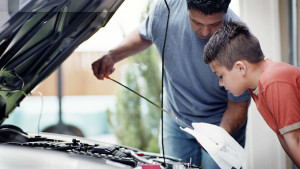Great car care tips!
Cleaning your car’s exterior is a simple process. Washing and waxing can be done at home or at any number of specialty cleaning shops in a matter of minutes. Cleaning and protecting the inside of your car is a chore that often gets overlooked until it’s too late. Protect your investment with these simple cleaning tips.
Before beginning to address the various areas of your car’s interior, vacuum. Using a vacuum to lift excessive dirt from the dash, floorboards and seats will help to keep airborne dirt to a minimum. A can of compressed air can be used to blow dust and grime from blower vents and dashboards.
GLASS and MIRRORS
Fingerprints, bugs and even dog’s noses can leave behind stains and markings on windshields, interior windows and mirrors that are difficult to remove. To avoid smearing, use an alcohol-based glass cleaner and begin at the top of the inside of your windshield, working your way toward the dash in a circular motion. (Note: If you have specially tinted glass, you’ll need to purchase an ammonia and alcohol free product or you’ll risk damaging your window’s special coating.) Use paper towels or newspaper to wipe and dry the glass. In a pinch, ammonia based cleaners (including many popular name brand glass and window cleaners) can be used on interior windows. They do tend to leave streaks though, so it’s best to have an alcohol based product or specially made windshield cleaner on hand for dealing with your car’s windshield.
DASH and DOORS
Dashboards and the interior of doors are made of a combination of materials usually consisting of plastics, rubber moldings, fiberglass and vinyl. Plastic surfaces can be cleaned with mild soapy water or any ammonia based cleaner. Using a soft bristled brush, rub the cleanser into the plastic and then, wipe dry with a soft cloth. Plastics are easy to clean, so you won’t need to do much work here.
For rubber moldings (such as those around the door frame), use mild, soapy water and a sponge. Shoe scuff marks can be removed with rubbing alcohol and cotton swabs, if necessary. Rinse and dry thoroughly.
Vinyl can be cleaned with soapy water, too. A sponge and a bit of dishwashing detergent can go a long way on dirty vinyl car seats and dashboards. For tougher stains, use a soft, bristled brush and rub in a circular motion. Rinse, and dry well.
Note: If you live in an area where your car is exposed to high temperatures or excessive sunlight, you may want to consider picking up a UV Sunscreen Protector/Cleaner. These products contain no water, produce a great shine and help to protect against fading and drying damage.
LEATHER INTERIOR
Leather makes for a beautiful interior. Unfortunately, it takes a lot of work to preserve that look. Body oils, clothing, dyes and cigarette smoke can cause discoloration and permanent damage to the delicate material in a matter of months. To keep your beautiful interior, condition your interior leather once a month. If you live in a particularly cold climate (where your car is exposed to below zero temperatures) or an extremely warm climate (where your vehicle’s interior is exposed to excessive heat and sunlight), you may want to consider doing this more often. You’ll need to condition after each cleaning. Leather needs regular replacement of natural oils or it will dry out, deteriorate, and crack. A mild pH balanced cleaner and conditioner can be used periodically to clean stains and debris from leather surfaces. Conditioning your leather after cleaning to help protect against future stains.
CLOTH INTERIOR
Cloth interiors are relatively easy to care for. Any cloth cleanser (including common household clothing stain removers) can be used on spills. Generally, vacuuming is enough to keep your seats looking great.
CARPET STAINS
Whenever possible, carpet spills should be treated immediately. When cleaning shortly after a spill, blot the area with an absorbent cloth and apply a carpet cleaning solution (or mild soapy water) to the area, allow to sit briefly, re blot and dry.
For tough dried on stains, begin by soaking the area with a carpet cleaner. (Mild soapy water will work, as well.) Allow the cleaning solution to penetrate into the stain and then, blot the area dry. Tough stains may need a second or third application.
Note: Not all stains can be removed due to differences in fibers, dyes, constructions, composition of the stain and the length of time the stain has been left unattended. This is why it’s best to treat spills immediately. Color test a discreet area before applying any chemical cleaner to your carpeting.
SPECIAL EMERGENCIES
CRAYON STAINS
If the kids got a little too busy in the back seat, there are some quick fixes for crayon messes. First, scrape what crayon you can off the area. You can do this with a spoon, metal edged spatula or dull knife. Spray WD-40 (or similar lubricant) on the stain and wait three to five minutes. With a stiff, bristle brush, work the area around the stain and then dry with paper towel. Reapply WD-40 and add a small amount of dishwashing detergent to the stain. With a damp sponge, work the fibers until the remainder of the stain lifts. Repeat, if necessary.
ODORS
Vomit, dog smells, food and other spills can cause big odor problems. If possible, clean and remove the offending smell from your car as soon as possible. When this isn’t an option, after cleaning, try absorbing the smell overnight with a bag of activated charcoal (commonly sold with fish aquariums). Open the bag and place it near the offending odor, providing a small amount of fresh air through a cracked window. The following day, if the odor is still present, repeat the process. For quicker odor removal, you can purchase a wide variety of commercial products that will do the same.
Sourced via allsands.com








